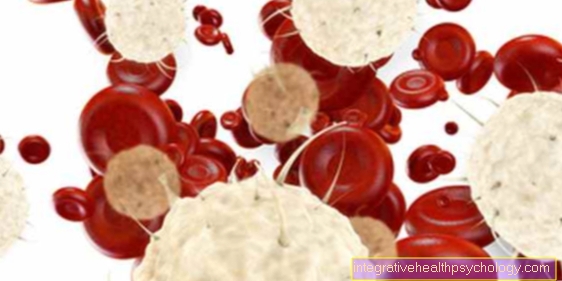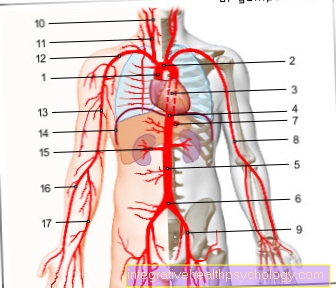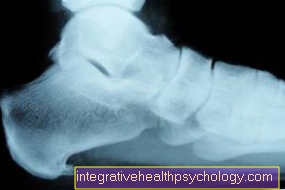Verapamil
introduction
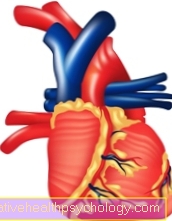
Verapamil (verapamil hydrochloride) is a so-called calcium channel blocker or a calcium channel antagonist. Verapamil belongs to the group of calcium channel blockers, which work on the calcium channels of the blood vessels and the channels in the heart. Verapamil thus stands in opposition to the group of calcium channel blockers that only affect the channels of the blood vessels (nifedipine type).
For this reason, verapamil is widely used for heart and vascular diseases. In principle, the mechanism behind the drug's mode of action is that a calcium channel is blocked, which plays a decisive role in the contraction of the heart and the muscle tension in the blood vessels.
Mode of action
calcium is a mineral that is essential for the human body. It sometimes ensures that the heart muscle can contract correctly and that the vessels in the body have the correct and necessary muscle tension. The calcium influx ensures sufficient concentration of the muscle fibers. The so-called Calcium channel blockers like verapamil can block a calcium channel in the cell and thus have one direct effect on the Strength of the heart muscle as well as the Muscle tension of the vessels. Due to the blockage of the canal, calcium can no longer flow into the interior of the cell and the strength of the muscles of the heart and the muscles in the blood vessels decrease.
This is due to the so-called action potential of the muscle cell, which is found in the muscle cells of the Heart as well as the muscle cell of the Vessels be controlled by calcium. The action potential in the so-called striated muscle cells in the body, which can be tensed at will, such as the biceps, does not depend on calcium. This explains why the consumption of verapamil affects the muscle contraction of the heart muscle and the muscles of the blood vessels, however has no effect on the other muscles in the body.
In certain diseases, the role of calcium can be used by blocking this channel and thus influencing the contraction of the heart or the wall tension of the vessels.
application

Verapamil is used in a number of cardiovascular diseases in which the effect of the blocked calcium channel is used. So is Verapamil especially at Cardiac arrhythmias, increased blood pressure as well as the coronary artery disease used.
Verapamil is one of the so-called Class IV Antiarrhythmicswhich is said to improve cardiac arrhythmias by blocking the calcium channel. It is important to note that, like all drugs that are used for cardiac arrhythmias, Verapamil itself can also cause irregular heartbeatif, for example, heart healthy People is applied.
The effect on the wall tension of the vessels can be seen in the treatment of essential hypertension, i.e. the high blood pressure, advantage. As the blood vessels expand, blood pressure is lowered. The same effect is also used in the treatment of coronary artery disease. With the help of verapamil, the Wall tension of all vessels reduced and thus expanded it. This also applies to the Coronary arterieswhich are clogged in the disease of CHD and thus enlarge the lumen by taking verapamil and thus the oxygen supply to the heart can be significantly improved.
Side effects
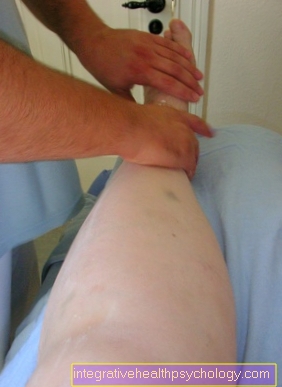
Like all drugs, verapamil cannot be used without side effects, some of which are more common than others. Up to ten percent of those taking verapamil suffer from side effects such as a headache, Dizziness, Edema on the ankles, Flush, or a noticeably slow heartbeat (Bradycardia). Rare side effects include the occurrence of one Cardiac arrhythmia or one allergic skin reaction.
It's important, that not the full dose at the beginning of therapy of verapamil should be taken. The blood pressure could then drop massively due to the vasodilating effect. This is prevented by slowly increasing the dose.
Through the Breakdown of verapamil in the liver and the related enzymes, occur when taking verapamil and other drugs or foods Interactions on. For this reason, the attending physician should be informed of the current medication intake before prescribing verapamil.
Since the study situation on the use of verapamil in pregnant women is very thin from one Use not recommended during pregnancy. If you are pregnant, you can switch to other drugs that have been adequately proven to be safe for the child and mother.
In general, if certain symptoms are felt while taking verapamil that appear unusual, the attending physician should be informed. They may adjust the dose or recommend a different medication for treatment if necessary.




